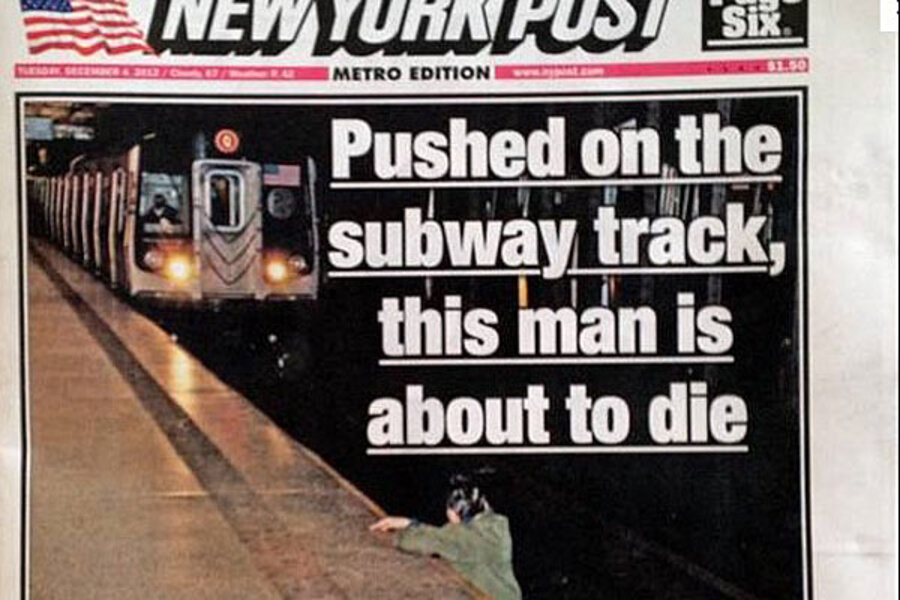New York Post subway photo: Should photographer have helped victim?
Loading...
| New York
Authorities said a suspect has implicated himself in the death of a New York man who was pushed onto the tracks and photographed just before a train struck him — an image that set off an ethical debate after it appeared on the front page of the New York Post.
The suspect was taken into custody on Tuesday after investigators recovered security video that showed a man fitting the description of the suspect working with street vendors near Rockefeller Center, said New York Police Department spokesman Paul Browne on Tuesday.
"The individual we talked to made statements implicating himself in the incident," Browne said. Police did not release his name and no charges were immediately announced.
Witnesses told investigators they saw the suspect talking to himself Monday afternoon before he approached Ki-Suck Han at the Times Square station, got into an altercation with him and pushed him into the train's path.
RECOMMENDED: Everyday heroes: Nine stories of Americans making a difference
Han, 58, of Queens, died shortly after being struck. Police said he tried to climb a few feet to safety but got trapped between the train and the platform's edge.
The New York Post published a photo on its front page Tuesday of Han with his head turned toward the train, his arms reaching up but unable to climb off the tracks in time. It was shot by freelance photographer R. Umar Abbasi, who was waiting to catch a train as the situation unfolded.
He told NBC's "Today" show Wednesday that he wasn't trying to take a photo of the man, but was trying to alert the motorman to what was going on by flashing his camera.
He said he was shocked that people nearer to the victim did not try to help in the 22 seconds before the train struck.
"It took me a second to figure out what was happening ... I saw the lights in the distance. My mind was to alert the train," Abbasi said.
"The people who were standing close to him ... they could have moved and grabbed him and pulled him up. No one made an effort," he added.
Ethical and emotional questions arose Tuesday over the published photograph of the helpless man standing before the oncoming train accompanied by the headline that read in part: "This man is about to die."
The moral issue among professional photojournalists in such situations is "to document or to assist," said Kenny Irby, an expert in the ethics of visual journalism at the Poynter Institute, a Florida-based nonprofit journalism school.
Other media outlets chimed in on the controversy, many questioning why the photograph had been taken and published.
"I'm sorry. Somebody's on the tracks. That's not going to help," said Al Roker on NBC's "Today" show as the photo was displayed Tuesday.
Abbasi said he did not control how the images were used in the Post, but he did tell the "Today" show he has sold the images.
Larry King reached out to followers on Twitter to ask: "Did the (at)nypost go too far?" CNN's Soledad O'Brien tweeted: "I think it's terribly disturbing — imagine if that were your father or brother."
The Post declined to share the photo with The Associated Press for distribution.
Subway pushes are feared but fairly unusual. Among the more high-profile cases was the January 1999 death of Kendra Webdale, who was shoved to her death by a former mental patient.
After that, the Legislature passed Kendra's Law, which lets mental health authorities supervise patients who live outside institutions to make sure they are taking their medications and aren't a threat to safety.
Mayor Michael Bloomberg said Tuesday that he believed that "in this case, it appeared to be a psychiatric problem."
The mayor said Han, "if I understand it, tried to break up a fight or something and paid for it with his life."
RECOMMENDED: Everyday heroes: Nine stories of Americans making a difference
_____
Associated Press writers Tom Hays and Tom McElroy contributed to this story.
Copyright 2012 The Associated Press.







